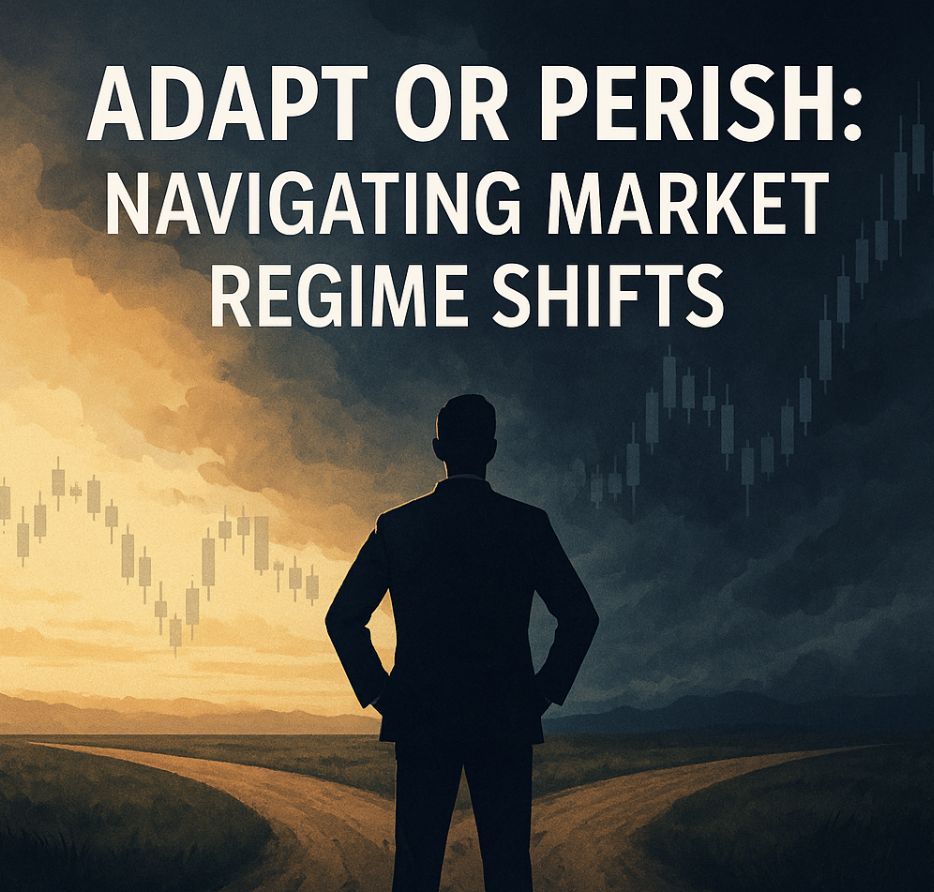When Your Strategy Stops Working: Surviving Market Regime Changes
When Your Strategy Stops Working: Surviving Market Regime Changes
By: Katie Gomez

The last two weeks of October 2025 have been brutal for traders as the market shifted from productive to destructive seemingly overnight, catching even experienced professionals off guard. Every trader eventually faces this gut-wrenching moment when confidence shatters, momentum dies across watchlists, and the uncomfortable realization sets in that what’s been working has stopped working—the crossroads where survival depends entirely on your next decision. This represents a fundamental market regime change in which the rules governing profitable setups have completely rewritten themselves, and traders clinging to yesterday’s playbook are getting destroyed.
The harsh truth separating long-term survivors from one-hit wonders is simple: the faster you recognize regime change and adapt your approach, the better your survival odds become, while the worst possible mistake involves stubbornly repeating failed strategies like a bird flying into the same window repeatedly, expecting different results while market conditions have fundamentally changed and won’t revert just because you need them to. The traders who survive are the ones who adapt fastest when the market makes adaptation non-negotiable.
Recognizing When the Market Has Changed
The signs that your strategy has stopped working are unmistakable once you’re willing to see them honestly:
- Consecutive losses following a period of success
- Setups that worked flawlessly last week are now failing consistently
- The market refusing to respond to technical signals that previously triggered reliable moves.
- Profitable patterns transforming into traps that reverse immediately after entry
- Momentum is subsiding across your entire watchlist as if someone flipped a switch on market behavior.
The analogy of a bird repeatedly flying into the same window perfectly captures the tragedy of traders stuck in this recognition failure—you’re expending energy, taking damage, and making no progress while stubbornly repeating the same failed approach, expecting different results. The market does not care about your expectations or needs; it is indifferent to your past success, your current capital requirements, or your psychological need for validation. The routes that generated profits yesterday may be closed entirely today simply because market conditions have evolved. Each failed trade compounds psychological damage beyond the monetary loss, capital erosion accelerates with stubborn repetition as you burn through buying power on setups that no longer work, opportunity cost mounts as you’re too busy forcing yesterday’s playbook, and confidence destruction from repeated failures takes exponentially longer to rebuild than the capital losses themselves.
What to Do When Momentum Dies
When you recognize your strategy has stopped working, immediate action becomes non-negotiable. It really doesn’t matter where you go, as long as you abandon what you were doing. Traders can choose to:
- Pull back by reducing position sizing dramatically
- Go cash entirely
- Change your trading style completely
- Mean reversion or range-bound strategies
- Go short if the market regime has flipped bearish, and fighting the trend is costing you money
- Stop trading entirely, because sometimes the best position is no position at all while you reassess conditions.
No matter what route you choose, setting ego aside proves critical at this crossroads. A disciplined trader prioritizes capital preservation over being “right,” and smart money consistently recognizes regime changes faster than stubborn money that bleeds capital trying to prove the market wrong rather than adapting to what actually is. Risk management must override ego completely in these moments, choosing to live to trade another day instead of forcing plays in hostile market conditions that are systematically destroying your setups.

The Cautionary Tale: Late 90s Traders
In the late 90s, we saw traders who made millions during the dot-com bubble become legends in the retail trading community, only to lose everything years later by stubbornly applying the same strategies to fundamentally different market conditions. They failed to recognize that their bubble-era tactics couldn’t work in normalized markets. Their downfall wasn’t a lack of skill but an ego-driven assumption that past success guaranteed future results, letting glory prevent the adaptation that separates one-hit wonders from long-term survivors, because making money is a lot easier than keeping it.
The Secret to Trading Longevity
The uncomfortable truth defining trading longevity is that market conditions evolve so rapidly that what worked five years ago may fail today, what worked five days ago may fail today, and what worked yesterday may fail today. This isn’t unfair or manipulative; it’s simply the market’s fundamental nature as a dynamic system constantly incorporating new information, participant behavior, and regime shifts. Respecting the market means acknowledging that it doesn’t care about your strategy, your ego, your capital requirements, or your past success, and that it will ruthlessly punish stubbornness by systematically destroying the accounts of traders who refuse to evolve, making survival contingent on constant adaptation and acute observation rather than loyalty to any single approach.
The rip current of yesterday will drown you if you don’t let go—clinging to strategies that once worked but no longer do guarantees you’ll be pulled under while the market moves on without you. Adaptation represents the core skill separating great traders from merely good ones, demonstrated by the willingness to completely abandon winning strategies the moment they stop working, by constantly testing new approaches while observing market feedback and adjusting accordingly, and by maintaining zero emotional attachment to any single methodology regardless of past success.’
Evolution or Extinction—Your Action Plan for Survival
Your immediate action plan starts now, if you are down more than 3-5 consecutive trades:
1.) Stop trading immediately to prevent making losses worse
2.) Review what actually changed in market conditions, including volatility regimes and sector rotation patterns
3.) Go to cash or reduce position sizing dramatically to preserve remaining capital
4.) Wait patiently for the new regime to establish recognizable patterns rather than forcing trades in chaos
5.) Paper trade new approaches to test adaptations before risking real money
6.) Return gradually with small positions that build back slowly as confidence and clarity return.
Trade Ideas becomes your essential tool during this transition by scanning for what IS actually working rather than what you wish was working. It helps identify new market leaders and emerging patterns that define the current regime, monitors regime indicators (sector rotation, market breadth, and volatility measures), and uses the Money Machine in simulation mode to test new parameters and strategies without risking capital while you adapt. Trading longevity has never been about finding one perfect strategy that works forever—it’s about recognizing the exact moment strategies stop working and adapting faster than the market can destroy you. The traders who survive market regime changes aren’t the most stubborn or confident but the most adaptable and humble in the face of the market’s ever-evolving nature, which respects no one’s past success or current needs.
